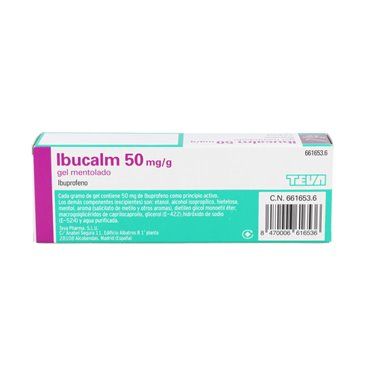Ibucalm - 5% Gel 60G
Ibuprofen, the active substance of this medicine, acts as a local analgesic and anti-inflammatory.
It is indicated to relieve local mild and occasional pain and inflammation caused by: small bruises, bumps, strains, torticollis or other contractures, low back pain and minor sprains caused by a twist.
Ibuprofen, the active substance of this medicine, acts as a local analgesic and anti-inflammatory.
It is indicated to relieve local mild and occasional pain and inflammation caused by: small bruises, bumps, strains, torticollis or other contractures, low back pain and minor sprains caused by a twist.
Ibucalm (50 Mg / G Menthol Gel 60 G)
ACTION AND MECHANISM
Ibuprofen is a non-steroidal [ANTIINFLAMATORY] and [ANALGESIC], which acts by preventing the synthesis of prostaglandins and other prostanoids, by inhibiting cyclooxygenase that is involved in inflammatory processes.
INDICATIONS
- Symptomatic local relief of painful or inflammatory conditions, of traumatic or degenerative origin of the joints, tendons, ligaments and muscles ([ARTRITIS], periarthritis, [CAPSULITIS], arthrosinovitis, [TENOSINOVITIS], [BURSITIS], distortions, meniscal lesions of the knee, [MUSCLE CONTRACTURE],
[TENDINITIS], [CONTUSION], [ESGUINCE], [LUMBALGIA], [TORTICOLIS], [MIALGIA], [LUXATION]).
POSOLOGY
DOSAGE:
- Exclusive external skin use.
- Adults and children over 12 years: Apply 3 to 4 times a day.
- Do not apply more than 7 days in a row without consulting the doctor.
RULES FOR THE CORRECT ADMINISTRATION
- Apply a thin layer of the product in the affected area with a light massage to facilitate penetration.
- Wash your hands after each application.
- Do not apply occlusive bandages.
CONTRAINDICATIONS
- Hypersensitivity to ibuprofen or any of the components of this medicine.
- [NSAID ALLERGY], [SALICILATE ALLERGY]: Although the local administration minimizes the risks arising from its systemic use, topical application, in large areas of the skin, in open wounds, mucous membranes or eczematous skin, prolonged and With the use of occlusive bandages, it can cause systemic effects, so it should be remembered that its use is not recommended in patients who have had allergic reactions (rhinitis, asthma, pruritus, angioedema, hives, shock or others), caused by acid acetylsalicylic or other NSAIDs due to the possibility of cross hypersensitivity.
PRECAUTIONS
- [ASTHMA]: asthmatic patients are more likely than other patients to develop hypersensitivity reactions to acetylsalicylic acid and other NSAIDs.
PATIENT ADVICE
- Avoid contact with eyes and mucous membranes.
- Do not use with occlusive dressings or apply simultaneously in the same area as other topical preparations.
- Do not use for prolonged periods of time or in large areas.
- Use only on intact skin, not on open wounds, mucous membranes or eczematous skin.
- Do not expose the treated area to the sun.
- Wash your hands after each application.
SPECIAL WARNINGS
- If the symptoms persist for more than 7 days or irritation or worsening occurs, the patient's clinical situation should be evaluated.
- A sun exposure of the treated area may cause photosensitivity.
INTERACTIONS
They have not been described in cutaneous use, since very low systemic concentrations of the drug are reached, but it will be assessed if it should be used in conjunction with other topical analgesics.
PREGNANCY
Although due to cutaneous use, systemic absorption is very small, the preparation should not be used during pregnancy, except for medical criteria, since NSAIDs, especially during the third trimester, can cause dystocia, delay childbirth and cause adverse effects on the fetal cardiovascular system. , such as premature closure of the ductus arteriosus.
LACTATION
Although due to cutaneous use the systemic absorption is very small, the preparation should not be used during breastfeeding unless medical criteria.
ADVERSE REACTIONS
- Moderate local [ERITEMA] (0.1% -1%), [DERMATITIS], [CUTANEOUS IRRITATION], [PRURITE] (0.1% -1%) and sensation of [CUTANEOUS IRRITATION] may occur in the area of application, which disappear upon discontinuation of treatment.
- [PHOTOSENSITIVITY REACTIONS] (0.01% -0.1%) may appear
- In the event that symptoms appear for which no justification is found, treatment should be discontinued and the patient's clinical situation will be reassessed.
- Prolonged topical administration, in large areas of skin, on open wounds, mucous membranes or eczematous skin, as well as the use of occlusive bandages, can cause the appearance of systemic adverse reactions typical of NSAIDs.
OVERDOSE
- Symptoms: Due to its external use, it is not likely that poisoning symptoms will occur.
In case of accidental ingestion, the symptoms of overdose will be systemic adverse reactions that will depend on the dose ingested and the time elapsed since ingestion.
- Treatment: if accidental ingestion occurs, stomach lavage and symptomatic therapy will proceed.



